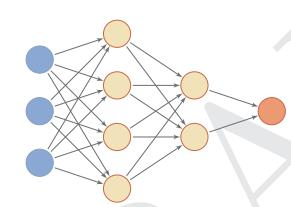BP神经网络 百度百科:传送门
BP(back propagation)神经网络:一种按照误差逆向传播算法训练的多层前馈神经网络,是目前应用最广泛的神经网络


#设置文件工作区间 setwd('D:\dat') #读入数据 Gary=read.csv("sales_data.csv")[,2:5] #数据命名 library(nnet) colnames(Gary)<-c("x1","x2","x3","y") ###最终模型 model1=nnet(y~.,data=Gary,size=6,decay=5e-4,maxit=1000) pred=predict(model1,Gary[,1:3],type="class") (P=sum(as.numeric(pred==Gary$y))/nrow(Gary)) table(Gary$y,pred) prop.table(table(Gary$y,pred),1)
实现过程
目的:通过BP神经网络预测销量的高低
数据预处理,对数据进行重命名并去除无关项
> #设置文件工作区间 > setwd('D:\dat') > #读入数据 > Gary=read.csv("sales_data.csv")[,2:5] > #数据命名 > library(nnet) > colnames(Gary)<-c("x1","x2","x3","y") > Gary x1 x2 x3 y 1 bad yes yes high 2 bad yes yes high 3 bad yes yes high 4 bad no yes high 5 bad yes yes high 6 bad no yes high 7 bad yes no high 8 good yes yes high 9 good yes no high 10 good yes yes high 11 good yes yes high 12 good yes yes high 13 good yes yes high 14 bad yes yes low 15 good no yes high 16 good no yes high 17 good no yes high 18 good no yes high 19 good no no high 20 bad no no low 21 bad no yes low 22 bad no yes low 23 bad no yes low 24 bad no no low 25 bad yes no low 26 good no yes low 27 good no yes low 28 bad no no low 29 bad no no low 30 good no no low 31 bad yes no low 32 good no yes low 33 good no no low 34 good no no low
nnet:包实现了前馈神经网络和多项对数线性模型。前馈神经网络是一种常用的神经网络结构,如下图所示

前馈网络中各个神经元按接受信息的先后分为不同的组。每一组可以看作一个神经层。每一层中的神经元接受前一层神经元的输出,并输出到下一层神经元。整个网络中的信息是朝一个方向传播,没有反向的信息传播。前馈网络可以用一个有向无环路图表示。前馈网络可以看作一个函数,通过简单非线性函数的多次复合,实现输入空间到输出空间的复杂映射。这种网络结构简单,易于实现。前馈网络包括全连接前馈网络和卷积神经网络等
使用neet()方法创建模型
neet()方法:
decay: 权重衰减parameter for weight decay. Default 0.
maxit: 最大迭代次数

x: 训练样本数据集的输入集合 y: x对应的训练样本数据集的标签(类)集合 weights: size: 隐层节点数, Can be zero if there are skip-layer units. data:训练数据集. subset: An index vector specifying the cases to be used in the training sample. (NOTE: If given, this argument must be named.) na.action: A function to specify the action to be taken if NAs are found. The default action is for the procedure to fail. An alternative is na.omit, which leads to rejection of cases with missing values on any required variable. (NOTE: If given, this argument must be named.) contrasts:a list of contrasts to be used for some or all of the factors appearing as variables in the model formula. Wts: 边的权重. If missing chosen at random. mask: logical vector indicating which parameters should be optimized (default all). linout: 是否为逻辑输出单元,若为FALSE,则为线性输出单元 entropy: switch for entropy (= maximum conditional likelihood) fitting. Default by least-squares. softmax: switch for softmax (log-linear model) and maximum conditional likelihood fitting. linout, entropy, softmax and censored are mutually exclusive. censored: A variant on softmax, in which non-zero targets mean possible classes. Thus for softmax a row of (0, 1, 1) means one example each of classes 2 and 3, but for censored it means one example whose class is only known to be 2 or 3. skip: switch to add skip-layer connections from input to output. rang: Initial random weights on [-rang, rang]. Value about 0.5 unless the inputs are large, in which case it should be chosen so that rang * max(|x|) is about 1. decay: 权重衰减parameter for weight decay. Default 0. maxit: 最大迭代次数 Hess: If true, the Hessian of the measure of fit at the best set of weights found is returned as component Hessian. trace: switch for tracing optimization. Default TRUE. MaxNWts: The maximum allowable number of weights. There is no intrinsic limit in the code, but increasing MaxNWts will probably allow fits that are very slow and time-consuming. abstol: Stop if the fit criterion falls below abstol, indicating an essentially perfect fit. reltol: Stop if the optimizer is unable to reduce the fit criterion by a factor of at least 1 - reltol.
model1=nnet(y~.,data=Gary,size=6,decay=5e-4,maxit=1000) # weights: 31 initial value 27.073547 iter 10 value 16.080731 iter 20 value 15.038060 iter 30 value 14.937127 iter 40 value 14.917485 iter 50 value 14.911531 iter 60 value 14.908678 iter 70 value 14.907836 iter 80 value 14.905234 iter 90 value 14.904499 iter 100 value 14.904028 iter 110 value 14.903688 iter 120 value 14.903480 iter 130 value 14.903450 iter 130 value 14.903450 iter 130 value 14.903450 final value 14.903450 converged
评估模型
> pred=predict(model1,Gary[,1:3],type="class") > (P=sum(as.numeric(pred==Gary$y))/nrow(Gary)) [1] 0.7647059 > table(Gary$y,pred) pred high low high 14 4 low 4 12 > prop.table(table(Gary$y,pred),1) pred high low high 0.7777778 0.2222222 low 0.2500000 0.7500000
得到混淆矩阵图后可以看出
检测样本为34个,预测正确的个数为26个,预测准确率为76.5%,预测准确率较低
原因:由于神经网络训练时需要较多的样本,而这里训练集比较少
